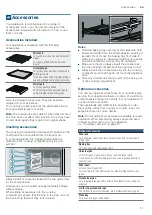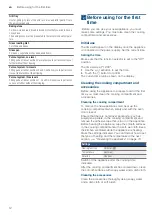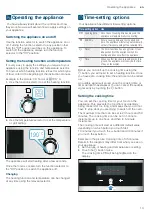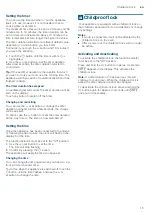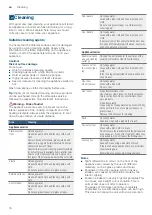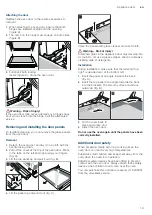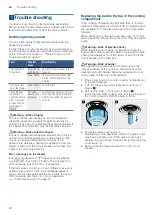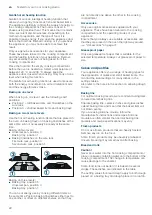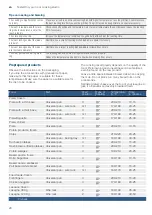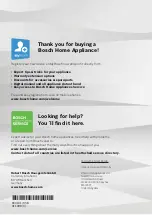
en
Tested for you in our cooking studio
24
Baking tips
Poultry, meat and fish
Your appliance offers you a range of heating types for
preparing poultry, meat and fish. You can find the ideal
settings for certain dishes in the settings tables.
Roasting on the wire rack
Roasting on the wire rack works particularly well for
large poultry or for multiple pieces at the same time.
Place the food to be grilled directly onto the wire rack. If
you are grilling a single piece, place it in the centre of
the wire rack for best results.
The universal pan should also be inserted at position 1.
This will catch the meat juices that drip down and keeps
the cooking compartment clean.
Add up to
^
litre of water to the universal pan,
depending on the size and type of joint. This will catch
the liquid that drips down. You can make a sauce from
these juices. This will also result in less smoke being
produced and keep the cooking compartment clean.
Roasting in cookware
:
Warning – Risk of injury caused by shattering
glass!
Place hot glass cookware on a dry mat after cooking. If
the surface is damp or cold, the glass may crack.
:
Warning – Risk of scalding!
Very hot steam may escape when opening the lid after
cooking. Lift the lid at the rear, so that the hot steam
can escape away from you.
Only use cookware which is suitable for use in an oven.
Glass cookware is best. Check whether the cookware
fits in the cooking compartment.
Shiny roasting dishes made from stainless steel or
aluminium reflect heat like a mirror and are therefore
not particularly suitable. The poultry, meat and fish
cooks slower and does not brown so well. Use a higher
temperature and/or a longer cooking time.
Observe the manufacturer's instructions for your
roasting cookware.
You want to find out whether the
baked item is completely cooked in
the middle.
Push a cocktail stick into the highest point on the baked item. If the cocktail stick comes out clean with no
dough residue, the baked item is ready.
The baked item collapses.
Next time, use less liquid. Alternatively, set the temperature 10 °C lower and extend the baking time. Adhere
to the specified ingredients and preparation instructions in the recipe.
The baked item has risen in the mid-
dle but is lower around the edge.
Only grease the base of the springform cake tin. After baking, loosen the baked item carefully with a knife.
The fruit juice overflows.
Next time, use the universal pan.
Small baked items stick to one
another during baking.
There should be a gap of approx. 2 cm around each item. This gives enough space for the baked items to
expand well and brown on all sides.
The baked item is too dry.
Set the temperature 10 °C higher and shorten the baking time.
The baked item is too light in colour
overall.
If the shelf position and the accessories are correct, then you should increase the temperature if necessary or
extend the baking time.
The baked item is too light on top, and
too dark underneath.
Bake the cake one level higher in the oven the next time.
The baked item is too dark on top,
and too light underneath.
Bake the cake one level lower in the oven the next time. Select a lower temperature and extend the baking
time.
The baked item is too dark in a tin or
loaf tin.
Place the baking tray in the middle of the accessory, not directly against the back wall.
The baked item is too dark in colour
overall.
Select a lower temperature next time and extend the baking time if necessary.
The baked item is unevenly browned. Select a slightly lower temperature.
Protruding greaseproof paper can affect the air circulation. Always cut greaseproof paper to size.
Ensure that the baking tin does not stand directly in front of the openings in the cooking compartment back
wall.
When baking small items, you should use similar sizes and thicknesses wherever possible.
You were baking on several levels.
The items on the top baking tray are
darker than those on the lower baking
tray.
Always select hot air when baking on several levels. Baked items that are placed into the oven on trays or in
baking tins at the same time will not necessarily be ready at the same time.
The baked item looks good, but is not
cooked properly in the middle.
Use a lower temperature and bake slightly longer; if necessary, add slightly less liquid. For baked items with a
moist topping, bake the base first. Sprinkle it with almonds or breadcrumbs and then place the topping on top.
The baked item cannot be turned out
of the dish when it is turned upside
down.
Allow the baked item to cool down for 5 to 10 minutes after baking. If it still sticks, carefully loosen it around
the edges again using a knife. Turn the baked item upside down again and cover it several times with a cold,
wet cloth. Next time, grease the baking tin and sprinkle with breadcrumbs.
Tested for you in our cooking studio
en
25
Uncovered cookware
To cook poultry, meat and fish, it is best to use a deep
roasting tin. Place the tin onto the wire rack. If you do
not have any suitable cookware, use the universal pan.
Covered cookware
When cooking with covered cookware, the cooking
compartment remains considerably cleaner. Ensure that
the lid fits well and closes properly. Place the cookware
onto the wire rack.
Poultry, meat and fish can also become crispy in a
covered roasting dish. Simply use a roasting dish with a
glass lid and set a higher temperature.
Grilling
Keep the appliance door closed when using the grill.
Never grill with the appliance door open.
Place the food to be grilled on the wire rack. In addition,
slide the universal pan in at least one shelf position
lower, with the slanted edge facing the appliance door.
Any dripping fat will be caught.
When grilling, try wherever possible to use pieces of
food which are of a similar thickness and weight. This
will allow them to brown evenly and remain succulent
and juicy. Place the food to be grilled directly onto the
wire rack.
Use tongs to turn the pieces of food you are grilling. If
you pierce the meat with a fork, the juices will run out
and it will become dry.
Do not add salt to the meat until it has been grilled. Salt
draws water from the meat.
Notes
■
The grill element switches itself on and off
repeatedly; this is normal. The grill setting
determines how frequently this occurs.
■
Smoke may be produced when grilling.
■
When you are using the grill, do not insert the baking
tray or universal pan into the cooking compartment
any higher than shelf position 3. The high
temperatures at the top of the cooking compartment
can warp accessories, which may damage the
cooking compartment when removed.
Meat thermometer
Depending on your appliance's features, you may have
a meat thermometer. You can cook accurately using a
meat thermometer. Read important notes on using the
meat thermometer in the corresponding chapter. There,
you can find notes on inserting the meat thermometer,
the possible heating types and additional information.
Recommended setting values
The setting values are based on the assumption that
unstuffed, chilled, ready-to-roast poultry, meat or fish is
placed into a cold cooking compartment.
In the table, you can find specifications for poultry, meat
and fish with default values for the weight. If you wish to
prepare heavier poultry, meat or fish, always use the
lower temperature. If roasting several joints, use the
weight of the heaviest piece as a basis for determining
the cooking time. The individual pieces should be
approximately equal in size.
The larger the poultry, meat or fish is, the lower the
cooking temperature and the longer the cooking time.
Turn the poultry, meat and fish after approx.
^
to
Z
of
the indicated time.
Poultry
When cooking duck or goose, pierce the skin on the
underside of the wings. This allows the fat to run out.
If using duck breast, score the skin. Do not turn duck
breasts.
Add some liquid to the poultry in the dish. Cover the
base of the ovenware with approx. 1-2 cm of liquid.
When you turn poultry, ensure that the breast side or
the skin side is underneath at first.
Poultry will turn out particularly crispy and brown if you
baste it towards the end of the roasting time with butter,
salted water or orange juice.
Meat
Baste lean meat with fat as required or cover it with
strips of bacon.
When roasting, add a little liquid if the meat is lean. A
covering of approx.
^
cm depth should be applied to
the base of any glass cookware.
Score the rind crosswise. If you turn the joint when
cooking, ensure that the rind is underneath at first.
When the joint is ready, turn off the oven and allow it to
rest for another 10 minutes in the cooking
compartment. This allows the meat juices to be better
distributed. Wrap the joint in aluminium foil if necessary.
The recommended resting time is not included in the
cooking time indicated.
It is more convenient to roast and braise meat in
cookware. You can take the joint out of the cooking
compartment more easily in the cookware, and prepare
the sauce in the cookware itself.
The quantity of liquid is dependent on the type of meat,
the cookware material and also on whether or not a lid
is used. If preparing meat in an enamelled or dark metal
roasting dish, it will need a little more liquid than if
cooked in glass cookware.
The steam evaporates in the cookware when roasting.
Carefully pour in more liquid if required.
The distance between the meat and the lid should be at
least 3 cm. The meat may rise.
If necessary, braise the meat first by searing it. Add
water, wine, vinegar or a similar liquid to the braising
liquid. A covering approx. 1-2 cm deep should be
applied to the base of the cookware.
Fish
Fish cooked whole does not have to be turned. Place
the whole fish into the cooking compartment in
swimming position with the dorsal fin facing upwards.
Placing half a potato or a small oven-proof container in
the stomach cavity of the fish will provide stability.
You can tell when the fish is cooked because the dorsal
fin can be removed easily.
When stewing, add two to three tablespoons of liquid
and a little lemon juice or vinegar into the cookware.
Содержание HHF133B.0B
Страница 2: ......

